By Megan Rule
Picture this – a city girl, born and raised, driving around a small town in Texas at 11 p.m. on a Saturday night looking for food but nothing’s open. The town seems to have boarded up at 8 p.m. On a Saturday night? What? How is it possible to go from the city that never sleeps, where there are concerts on Tuesday nights and diners are open 24/7, to a town that’s smack in the center of Texas with only one building that could pass as a skyscraper?
Record scratch… freeze frame…you’re probably wondering how I ended up in this situation.
I’m from Stamford, Conn., which is about 40 minutes outside of Manhattan. All I’ve ever known is the fast-paced city lifestyle, people with places to go and things to do and heels clicking as they rush to get somewhere else. A city where it seems the days are shorter and the hours go by faster. And I go to school in Waco, Texas, which is the complete opposite. Now, I’m probably over-exaggerating a bit. Waco isn’t exactly a one-horse town with tumbleweeds coming through, but the first time I came here that’s how I felt.
The first time I came to Waco to visit the Baylor campus was a culture shock. My mom and I instantly felt that as soon as we left the “Baylor bubble” we were out of place, lost in a town that seemed stuck in the 1970’s. When move-in day came around I was a little scared, this totally wasn’t my environment. And the thought of spending four years in this small town that wasn’t in my element was definitely a fear that was mixed in with the moving in nerves.
Fast-forward almost two years, and I’m finishing up my sophomore year of school happier than ever. This “small town” has come to be a town that I call home. It’s my home away from home; it somehow found a way to grab a hold of my heart. This city girl at heart found a way to enjoy the small town in Texas and make the most out of everything, finding adventure around the corner.
Waco is a really cool town. Waco is what you make of it. When your attitude is positive, it’s easier for the outcome to be positive as well.
Sure, it’s not as big as my home but it’s got its own quirks that make it so cool. Halfway through the summer I find myself wanting to come back and pick up my adventures where I left off. The thing about Waco is that everyone here is so different; the people here make the town. And because the people make the town, the people know different things about the town. If I hang out with a different group of people every night of the week, I’ll end up doing seven completely different things. From hidden spots of beauty to hole-in-the-wall restaurants to quirky thrift stores, everyone has made something completely different out of Waco so that there’s something new to find around every corner. Whenever it feels like I’ve exhausted all there is to do, someone new opens my eyes.
Waco isn’t New York City, Waco isn’t Chicago and Waco isn’t Los Angeles because Waco is Waco. Sure, there may not be concerts on random weeknights and it may be hard to find a restaurant open past 8 p.m., or anything open on a Sunday, but that’s alright because it’s a change I’ve learned to embrace. Change makes a person grow, and if it weren’t for living in the Waco culture the past few years, I wouldn’t be who I am now.
 Megan Rule is a sophomore at Baylor University pursuing a major in journalism and a minor in Business Administration and Spanish. She is on the Baylor Cross Country and Track team and is a staff writer for the Baylor Lariat. In addition to running and writing, she enjoys spending time with her dog and family.
Megan Rule is a sophomore at Baylor University pursuing a major in journalism and a minor in Business Administration and Spanish. She is on the Baylor Cross Country and Track team and is a staff writer for the Baylor Lariat. In addition to running and writing, she enjoys spending time with her dog and family.
The Act Locally Waco blog publishes posts with a connection to these aspirations for Waco. If you are interested in writing for the Act Locally Waco Blog, please email [email protected] for more information.
By Eric Martin
Most people don’t enjoy their drives to work. In surveys, Texans rank commuting dead last in our preferences among daily activities. That’s not surprising: driving is frustrating and remarkably bad for our health, causing sleep loss, backaches, and higher blood pressure. It’s also bad for our social and personal lives: long commutes have been associated with loneliness and higher divorce rates [1].
Although we dislike long commutes, and we know they’re bad for our health, our commutes keep on growing, and the average American now spends 52 minutes a day just getting to and from work. That’s an astonishing waste of time and potential. More time in cars means less time invested in family, friends, or pursuits that matter to us.
Thankfully, most Wacoans don’t need to endure such long commutes, but we’ve followed the same trends as the rest of the country, living farther from places of work and so spending more of our time in cars.
We sacrifice that quality time because we think its loss will be made up for by other benefits. Sometimes, it’s a larger house in the suburbs. At other times, it’s the larger paycheck from a new job farther from home. But it turns out that those advantages do not outweigh the downsides of spending our lives in cars: on the whole, people report they are less happy when they accept longer commutes.
This trade-off of is so well known that researchers even have a name for it: “the commuting paradox” [2]. It seems paradoxical because we willingly make a trade-off that decreases our own wellbeing. We overestimate the benefits of bigger houses and paychecks, and underestimate the downsides of long commutes and loss of community.
Higher income and larger houses do make us happy, but only for a while. We quickly adapt to them, and then they stop conferring much happiness. Curiously, we don’t adapt to social isolation. It turns out, we are often wrong about what will make us happy.
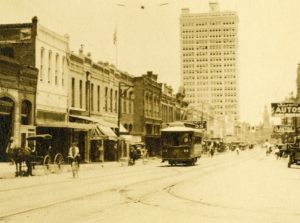
Photo courtesy of the Texas Collection, Baylor University
Driving wasn’t always our preferred option for getting around town. In the past, Wacoans commuted by other methods: we walked, biked, and took streetcars to get around town. In central Texas, the Interurban Railway got Wacoans through town and connected us with McKinney, Denison, and Dallas. An incredible 819,000 passengers used this system at its peak in 1920 [3].
Single-passenger vehicle driving only became our dominant mode of transportation when Texans left cities for the suburbs in the 1950s, 60s, and 70s. The history of our car driving is strongly connected with the history of our flight from cities. (I have previously written about the destructive effects of “white flight” in Waco here.)
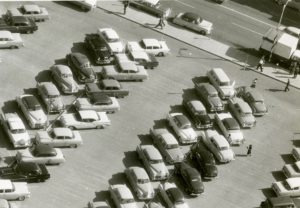
Photo courtesy of the Texas Collection, Baylor University
But there is an attractive alternative to such trends – an alternative which might encourage us to think about living in closer proximity to our places of work, school, and shopping: the trusty bicycle!
Bicycle commuting just makes sense in Waco. We already benefit from wide roads with plenty of space for multiple user groups, and we also enjoy good weather for most of the year. Additionally, the city plans to invest in more bike lanes that will help connect residential areas with employment and economic centers.
For me, getting to and from work isn’t the worst part of my day; it’s often one of the best parts. Here are a few of the tangible ways that cycling around Waco improves my own quality of life:
+ Cycling gets me places faster. This may seem counter-intuitive, but given that about half of all our car trips are within 3 miles of home, you’d be surprised how fast the journey can be on a bike. When I subtract the time I would have spent parking, most of these shorter trips are actually faster on a bike than in a car.
+ Cycling saves me money. Between gas, oil changes, and repair, driving a car is expensive. City driving is especially hard on cars and requires regular maintenance. Bicycles are cheap by comparison, costing less than public transit and far less than cars.
+ Cycling is free exercise. I feel more energetic and healthy when I get even a few minutes of physical activity every day. No need for that pricey gym membership when you’re getting around town by bike.
+ Cycling supports our local economy. I’m happy when my money stays in Waco rather than going to corporate offices in some faraway city. Local economies flourish when more people are walking and cycling compared with driving [4].
+ Cycling doesn’t pollute the air. About 600,000 children in Texas have asthma, and over 500 of them are hospitalized each year on account of it [4]. We know that pollutants from our cars cause asthma and other respiratory diseases. If Wacoans want to “love one another,” then we must ask how our own behavior affects our neighbors’ wellbeing.
+ Cycling is simply an elegant way to travel. I’m dependent only on a simple machine, and I feel free while using it. Cycling connects me with parts of my environment that I’m otherwise isolated from: the city’s topography, the weather, and the people in my community.
What about safety? Isn’t cycling dangerous? It’s true that being on the roads with cars takes some practice and caution. And our city can help make cycling safer with better infrastructure such as bike lanes. But that said, cycling may not be as dangerous as you think. Recall that the exercise from cycling imparts substantial health benefits and decreases risk from the leading causes of death.

Photo courtesy of the Texas Collection, Baylor University
While automobiles clearly have their uses, by and large, they haven’t made Americans happier, and they often make us less happy. That could prompt you to try something new. More and more Americans are commuting by bicycle. You might be surprised to rediscover how fun it can be.
 Eric Martin is an Assistant Professor of History & Philosophy of Science at Baylor University’s Great Texts Program. When he’s not at work, he can be found riding his bicycle, exploring Cameron Park, or enjoying coffee.
Eric Martin is an Assistant Professor of History & Philosophy of Science at Baylor University’s Great Texts Program. When he’s not at work, he can be found riding his bicycle, exploring Cameron Park, or enjoying coffee.
The Act Locally Waco blog publishes posts with a connection to these aspirations for Waco. If you are interested in writing for the Act Locally Waco Blog, please email [email protected] for more information.
Notes:
[1] See Daniel Kahneman and Alan B. Krueger. 2006. “Developments in the Measurement of Subjective Well-Being” Journal of Economic Perspectives 20:1 3–24; Robert D. Putnam. 2000. Bowling Alone: the Collapse and Revival of American Community. New York: Simon & Schuster; Erica Sandow. 2014. “Til Work Do Us Part: The Social Fallacy of Long-distance Commuting” Urban Studies 51:3 526-543.
[2] Alois Stutzer and Bruno S. Frey. 2004. “Stress That Doesn’t Pay: The Commuting Paradox” IEW – Working Papers 151, Institute for Empirical Research in Economics, University of Zurich.
[3] Terri Jo Ryan, “Interurban Railway,” Waco History, accessed November 26, 2016, http://wacohistory.org/items/show/117.
[4] Tanya Snyder, “Bicycling Means Business: How Cycling Enriches People and Cities,” StreetsBlog USA, accessed November 26, 2016, http://usa.streetsblog.org/2013/03/08/bicycling-means-business-how-cycling-enriches-people-and-cities/
[5] http://www.cdc.gov/asthma/stateprofiles/asthma_in_tx.pdf
by Rick Allen
 It starts as a trickle, within a few minutes it becomes a flood and within an hour or so it is gone. No, I am not writing about Waco Creek at the height of a Texas flash flood. I am describing the visceral experience that we who live on Colcord Avenue call “Halloween on Colcord.”
It starts as a trickle, within a few minutes it becomes a flood and within an hour or so it is gone. No, I am not writing about Waco Creek at the height of a Texas flash flood. I am describing the visceral experience that we who live on Colcord Avenue call “Halloween on Colcord.”
Only a decade ago, the numbers were high but manageable. Five hundred to eight hundred trick or treaters plus their parents would visit our stretch of Colcord for a couple of hours once a year. No big deal…but then we began to ask our neighbors in other neighborhoods about how BIG Halloween had become. “Oh yes”, they would exclaim, “We went from 20 to 30 trick or treaters this year”. We would eye them suspiciously…Were they even home? Were they turning off their light at 7:00pm? Had they run out of the whole bag of 25 Snickers? When we regaled relatives in Omaha of our fright night experience of hundreds of munchkins and their parents in 2 hours, we would be derided for embellishing our stories with Texas braggadocio.
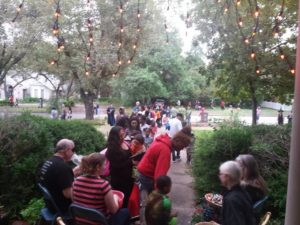 Then it really took off. About ten years ago, Ryan and Kristen R. enlisted their Sunday school class to do a hot dog give away and outdoor carnival. The first year, they gave away 500 dogs with chips and a drink. The next year…the word was out. People began car pooling their kids to Colcord. We upped the ante to prepare for the onslaught. By 5 years ago we were handing out over a thousand pieces of candy in 2 hours. We called in reinforcements; first from the neighborhood, then, HEB and friends from across the city. We set up candy stations with shifts of 30 minutes as we would wear out handing a child a piece of candy and commenting on how lovely their witch costume or Spiderman costume was. We enlisted the City of Waco to supply barriers to block off 3 blocks for the children’s safety. Last year, the Good Neighbor House (who took over the hot dog grilling) handed out over 800 hot dogs. The Capps, at the head of the blocked off street, handed out 2000 pieces of candy. We ran out of candy and wore out five adults by 7:30. Our final bag count was 1,550 pieces. Yes, from 5:30 when the two to three year olds come with mom to 7:00 when kids come running in groups of five to seven to get in line to 7:30 when we darken the whole house to let the stragglers know that we are bereft, empty and exhausted of candy supplies, it comes and goes. By 8:00 we secretively wander out to open the barricades once more and life returns to “normal” on Colcord.
Then it really took off. About ten years ago, Ryan and Kristen R. enlisted their Sunday school class to do a hot dog give away and outdoor carnival. The first year, they gave away 500 dogs with chips and a drink. The next year…the word was out. People began car pooling their kids to Colcord. We upped the ante to prepare for the onslaught. By 5 years ago we were handing out over a thousand pieces of candy in 2 hours. We called in reinforcements; first from the neighborhood, then, HEB and friends from across the city. We set up candy stations with shifts of 30 minutes as we would wear out handing a child a piece of candy and commenting on how lovely their witch costume or Spiderman costume was. We enlisted the City of Waco to supply barriers to block off 3 blocks for the children’s safety. Last year, the Good Neighbor House (who took over the hot dog grilling) handed out over 800 hot dogs. The Capps, at the head of the blocked off street, handed out 2000 pieces of candy. We ran out of candy and wore out five adults by 7:30. Our final bag count was 1,550 pieces. Yes, from 5:30 when the two to three year olds come with mom to 7:00 when kids come running in groups of five to seven to get in line to 7:30 when we darken the whole house to let the stragglers know that we are bereft, empty and exhausted of candy supplies, it comes and goes. By 8:00 we secretively wander out to open the barricades once more and life returns to “normal” on Colcord.
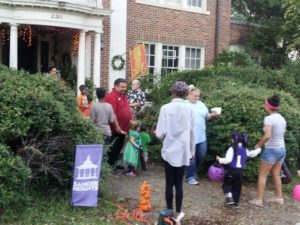 You may ask why? Why us? Why continue? Our church has been teaching us adults more about hospitality and doing for the least of these with no thought of earthly or spiritual gain…maybe that is it. I know I do it because there is no delight like seeing wee ones dressed up in costumes and taking their first tentative steps at socialization by saying, “trick or treat” and then after the candy drops into their bucket, saying, “thank you”.
You may ask why? Why us? Why continue? Our church has been teaching us adults more about hospitality and doing for the least of these with no thought of earthly or spiritual gain…maybe that is it. I know I do it because there is no delight like seeing wee ones dressed up in costumes and taking their first tentative steps at socialization by saying, “trick or treat” and then after the candy drops into their bucket, saying, “thank you”.
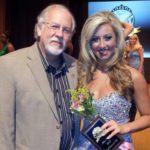 Rick Allen has worn many hats since coming to Waco in 1982. He has been a history and English teacher, social worker, therapist, special educator, school counselor, Dean of Students, Waco City Councilman, landscaper, xeriscaper, pedicab entrepreneur, B&B host, board member, Sunday school teacher, junior college instructor, MHMR curriculum writer, public speaker, blogger and dad.
Rick Allen has worn many hats since coming to Waco in 1982. He has been a history and English teacher, social worker, therapist, special educator, school counselor, Dean of Students, Waco City Councilman, landscaper, xeriscaper, pedicab entrepreneur, B&B host, board member, Sunday school teacher, junior college instructor, MHMR curriculum writer, public speaker, blogger and dad.
The Act Locally Waco blog publishes posts with a connection to these aspirations for Waco. If you are interested in writing for the Act Locally Waco Blog, please email [email protected] for more information.
By Hope Mustakim
September 22, 2016 –
Today I sat in a room with 10 professionals from various agencies as they thoughtfully coordinated how to best serve some of the brightest yet most needful students of Waco ISD. This partnership follows a wrap-around concept in student transitions from Wiley Opportunity Center (“Alternative” or DAEP) and the Brazos High School Credit Recovery Center, back to their home campus. I observed as these passionate, astute individuals collaborated to provide holistic care for those students who demonstrate conduct that hinders them from succeeding in a traditional school setting- and often, in the “real world,” too. Most striking to me was how the students were spoken about- their privacy was respected, they were not blamed or resented, and they were not seen as “problem” kids, but children who had socio-emotional needs that for whatever reason weren’t being met. The meeting was solutions-oriented and hopeful.
Most (if not all) of these students want to be successful; what child does not? Their young lives are full of potential for restoration and achievement. With that in mind, this group of social workers, mental health professionals, and school administrators balanced the coordination of student services with the importance of parental inclusion, education, and support, recognizing the impact that the family unit has in the restoration of the child to his or her home campus and their overall success in society.
The continuum of care includes things like: on-campus crisis intervention, “triage” and case management, life skills training, intensive therapy for those dealing with trauma, and weekly check-in visits by the child’s home campus administrators. This group also shared ways students can be celebrated when they return to their campus and how they can be supported in applying their new skills to the traditional school setting. This team recognized that all children should be celebrated. And these children, with the right supports, can contribute to our campuses in ways that we don’t even realize we’re lacking.
I was incredibly inspired as I listened to this workgroup strategizing and witnessed their labor of love. A few times tears welled up in my eyes, because I know that any one of these students – by chance, by choice, or circumstance – could be my child. To see the level of humility, determination, and commitment from this partnership at Waco ISD deepened my love and appreciation for Waco and everything that makes it wonderful. #wacoiswonderfull
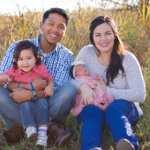 Hope Mustakim is a Community Practice graduate student intern for the BEAR Project- a collaboration between the Garland School of Social Work (Baylor) and Waco ISD. She is a mother of a toddler and an almost-toddler, and wife to an incredibly supportive partner as they pursue the good work of Loving thy Neighbor. Hope is an active member of the Waco community with experience in education, policy advocacy, and community organizing.
Hope Mustakim is a Community Practice graduate student intern for the BEAR Project- a collaboration between the Garland School of Social Work (Baylor) and Waco ISD. She is a mother of a toddler and an almost-toddler, and wife to an incredibly supportive partner as they pursue the good work of Loving thy Neighbor. Hope is an active member of the Waco community with experience in education, policy advocacy, and community organizing.
By Leilani Mueller
Three nights ago Felicity, my one-year-old daughter, tried running. She was wearing her long maxi-dress, with the ruffles around the top and the bottom. She tried with all her little might to run after her two-year-old friend who had a ball. Into the long grass, she went. The thick grass was taller than her knees. She stumbled on the grass and her skirt, but stood up again, and again. She tried so hard.
Three weeks ago she took her first step in California. Three weeks ago I was living in California. Not anymore.
People ask, “How do you like Waco? What do you think of moving?”
Putting into words the experience of moving is difficult. On the one hand, there is something so ordinary about it. Yesterday, I sang to my baby and put her to bed. This morning, I went for my mile run. I dropped Nathan off at school, carpooling, the same as we’ve always done. Yet, it is different. Here, Felicity has a room of her own. The brick buildings of the classically, beautiful Baylor campus put Makita Tool company’s white, rectangular office to aesthetic shame. And the air is thick here. It sticks to you when you run. You notice it. Three weeks is not enough time to really know what I think.
As I reflect, I wonder about the story I choose to tell about this place. I find myself wondering, can I determine my experience of Waco? (Clearly, I’m motivated by the fact that my husband is a philosopher) Over the past six months, when I told people I was moving to Waco a range of responses came my way.
“It’s the armpit of Texas.”
“Growing up here is the best.”
“It’s exciting.”
“I hate it.”
“I love it.”
And the one agreed upon thought: “It’s hot in the summer.”
One place manages to elicit a range of contrary emotions. Perhaps the place is just a backdrop. It is me who gets to decide who I will be in this place. And I can love it as much as the familiar streets of Harbor City, the eclectic eateries in Los Angeles, the winding pavement of Oxford. But to love it, is also to admit that it is not those other places. And it is OK to miss them. But it is also OK to love this place, which isn’t to be disloyal to the other places I belong.
My experience of Waco is a walking one. I try to run in this thick new grass, but I will stumble sometimes.
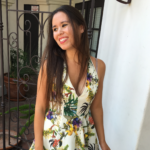 Leilani Mueller is a wife, mother, teacher, and writer. Formerly, a California native she now calls Waco home. She loves YA novels, Shakespeare, Victorian literature, Baylor philosophy, and Pumpkin Spice Lattes.
Leilani Mueller is a wife, mother, teacher, and writer. Formerly, a California native she now calls Waco home. She loves YA novels, Shakespeare, Victorian literature, Baylor philosophy, and Pumpkin Spice Lattes.
The Act Locally Waco blog publishes posts with a connection to these aspirations for Waco. If you are interested in writing for the Act Locally Waco Blog, please email [email protected] for more information.
by Rachel Lynne Wilkerson
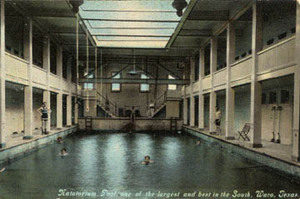
1910 post card showing the artesian-fed pool at the Natatorium Hotel in Waco.
Spectators familiar with the BSR Cable Park’s rise to internet celebrity a few summers ago might be surprised to learn that Waco has been a destination for water activities for a century. Before lazy rivers and slides that launch swimmers into the air, the Waco Natatorium built by Confederate army veteran Robert B. Parrotton at 4th and Mary Ave. offered mineral waters and baths. The indoor pool enticed bathers from all over to travel to Waco for a dip long before Waco was a viral water slide sensation.
Pools are critical gathering places for children and families in the summer months when school is out of session. They provide employment opportunities for older children, recreational activities for the whole family. A recent UK study found that swimming provides a positive boost on well being comparable to going to the library or playing music. Swimming is good for our physical, emotional, and social well-being. Additionally, public pools and baths in Waco and beyond have always played a tremendous role in creating community space. The ancient roman baths are the modern day equivalent of community centers—a place for lively discussion and a healthy exchange of ideas.
With these benefits in mind, I’d like to pose a question: why doesn’t Waco have more public pools?
This was one of the first questions I asked moving back to Waco three years ago. While the options for high-flying (and high-priced) water parks abound, I couldn’t find very many public places to swim laps. The public options seemed limited to the local Ys with limited time tables. The Center at Columbus Avenue Baptist Church, built in an old Y, offered an indoor pool at the odd length of two thirds of the standard competition dimensions. No city pools were in sight.
City officials have given various explanations for the closing of the pools: outdoor swimming pools are out of vogue, city-operated swimming pool usage is too low, refurbishing the pools would require raising taxes, splash parks are the best substitute. And yet, the absence of public pools is increasingly noticeable and a real loss as high summer in Central Texas continues.
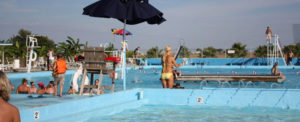 Waco’s strained relationship with public city pools, and its history of valuing big ticket amusement water parks echo underlying tensions across neighborhoods in the city. Residents informed me that Waco closed all of its public pools over the last two decades. The last pool closing is well known as the site for Hawaiian Falls. Whatever their cost constraints for traditional outdoor pools, The City of Waco contributed 2.5 million to the construction of Hawaiian Falls. For those unable to travel to the park or pay the entrance fee, Waco offers splash parks. I do not have the numbers to substantiate the City’s claims on the sustainability of outdoor pools, but I know that pools thrive in some other mid-sized and small cities, the Playdium Pool in West for example. As a lifelong swimmer and proud Texan, I can tell you that no one, for a moment, thinks a splash park is equivalent to submerging into a chilly summer pool on a hot Texas day.
Waco’s strained relationship with public city pools, and its history of valuing big ticket amusement water parks echo underlying tensions across neighborhoods in the city. Residents informed me that Waco closed all of its public pools over the last two decades. The last pool closing is well known as the site for Hawaiian Falls. Whatever their cost constraints for traditional outdoor pools, The City of Waco contributed 2.5 million to the construction of Hawaiian Falls. For those unable to travel to the park or pay the entrance fee, Waco offers splash parks. I do not have the numbers to substantiate the City’s claims on the sustainability of outdoor pools, but I know that pools thrive in some other mid-sized and small cities, the Playdium Pool in West for example. As a lifelong swimmer and proud Texan, I can tell you that no one, for a moment, thinks a splash park is equivalent to submerging into a chilly summer pool on a hot Texas day.
The city of Waco and its residents have the chance to mend a longstanding rift. In 1964, the Waco Community Relations Committee, succeeded in desegregating all City park and recreation facilities except swimming pools. The current options for cooling off in the summer heat are geared towards a mobile segment of the Waco population—those who can pay the entrance fees and have access to transportation. Waco deserves better. To Dr. Roger Olson and other community advocates, city pools are “a local justice issue.” As Waco grapples with its history, community pools could be a step towards mending fissures in our community.
Pools aren’t cheap, but the merits of communal space, shared conversation, and a way to cool off in the summer outweigh the costs. The portrait of Waco as a water wonderland is not the whole story; our city has limited recreational options for children in the summer. Pools are a natural common space for parents and families to gather, for sun-soaked friends to exchange ideas, for each of us to meet people outside of our own ruts of social circles. Traditional city pools are vital to communities, and Waco residents, all Waco residents, deserve access to public pools.
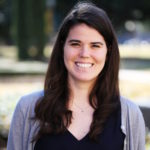
Rachel Lynne Wilkerson studies statistical modeling with an eye towards applications in the food system. A staunch advocate for pie as a catalyst for gathering neighbors together, Rachel thrives on open water swimming and front porch conversations.
The Act Locally Waco blog publishes posts with a connection to these aspirations for Waco. If you are interested in writing for the Act Locally Waco Blog, please email [email protected] for more information.
By Ana Chatham
People often ask me how I, being born and raised in Brazil, ended up here in Waco. I usually respond with the briefest summary of my immigration story I can produce. Being a private person who normally dislikes small talk, it is comfortable for me to omit the details and just stick to the easy, pleasant stuff – all the great things that have brought me and kept me in this country: opportunities to grow as a person and as a professional. For the sake of time and efficiency, I usually leave out what I consider to be some of the most important parts of my story: the parts that have to do with faith and loss.
Although I am a person of faith, I don’t usually tell people that it was a deep sense of calling and an unexplainable peace that led me to accept an opportunity about which I knew little, in a country where I only had a few acquaintances, when I was only 18 years old. I don’t normally talk about how my faith was truly what motivated me to come to the USA and strengthened me to stay.
I also hesitate to talk about loss. But, as we all know, you can’t go anywhere without leaving somewhere behind. Yes, my immigration journey has added so much to my life – relationships and life experiences, just to name a couple of things. But it has also caused me to mourn the loss of so much – relationships and life experiences, just to name a couple of things. The greatness of what I have here doesn’t diminish the greatness of what I left behind, even if the greatness of what is left behind is only perceived by my own eyes and heart.
This February, ten years after I first arrived in the USA, I pledged allegiance to the flag of the United States of America, along with another 500 or so immigrant persons. The whole process of becoming an American citizen made me think deeply about the many immigrants I have met, mostly through my work in various non-profits. Each story is unique, yet similar in the sense that they are often themed with faith, hope, resilience, and loss, much like my own immigration journey.
In a time where the prevailing message about immigrants seems to be around what we come here to gain, take, use, and abuse, it is easy to forget what we had to leave and lose. And it is easy to forget how those choices were motivated by faith – faith in a better future, faith in the American Dream, faith in a higher power, faith in the power of hard work and sacrifice – the same types of faith the motivates non-immigrants to do what has been set in their hearts for the betterment of themselves and their families.
May we be a community that seeks to understand and honor people, local and immigrant, in the wholeness of their stories. May we listen to each other instead of the loud, often hateful, noise from our electronic devices. May we celebrate each other’s journeys and realize that though our journeys may have involved different steps, the underlying themes are often the same.
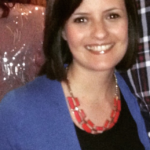 Ana Chatham is a social worker at a local nonprofit. She is also a member of the Waco Immigration Alliance and of the Latino Mental Health Coalition. When not at work, Ana enjoys spending time with her husband, her friends, and her two dogs, Crosby and Cody. She can be contacted at [email protected].
Ana Chatham is a social worker at a local nonprofit. She is also a member of the Waco Immigration Alliance and of the Latino Mental Health Coalition. When not at work, Ana enjoys spending time with her husband, her friends, and her two dogs, Crosby and Cody. She can be contacted at [email protected].
The Act Locally Waco blog publishes posts with a connection to these aspirations for Waco. If you are interested in writing for the Act Locally Waco Blog, please email [email protected] for more information.
By Anastasia Roberts
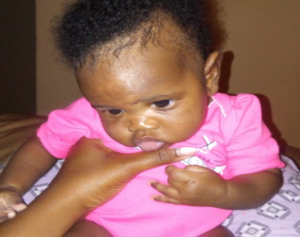 Life is such a beautiful anomaly. Three months ago I was blessed and honored to give birth to a little baby girl named Analee. She took my world and flipped it into a disarray…in the best way possible. After giving birth to Analee, I began to think a little more critically about the precious gift we call life.
Life is such a beautiful anomaly. Three months ago I was blessed and honored to give birth to a little baby girl named Analee. She took my world and flipped it into a disarray…in the best way possible. After giving birth to Analee, I began to think a little more critically about the precious gift we call life.
For me, at one end of a spectrum life is a beautiful new born child and the other end an individual encountering death and contemplating afterlife. There are also all of the complexities, examinations, and enjoyment life has to offer in between. Along with engaging in the excitement of a new life, recently I have felt the sadness from the modern day strange fruit embedded in our nation of violent death.
The past few weeks, we have dealt with life ending through violence, anger, hate. These deaths make me question how life escapes us suddenly and why? Again, I began to evaluate life and this time I think about how I want to teach my daughter the value of a person’s life. This is somewhat of a cathartic process for me and hopefully will benefit my daughter in the long run.
As a Christian, I believe we have life in the image of God. Genesis 1:27 says, “So God created mankind in his own image, in the image of God he created them; male and female he created them” (NIV, 2013). In my eyes, alone, being created from God, I choose to value life. Having the unique breath of life makes an individual worthy of love, care, compassion, justice, and freedom to live with others. Being made in God’s image, I believe we can live courageous lives. (Side note: Specifically, I am talking about human life.)
I would like for my daughter to have courage to believe all things are possible and that her value is beyond material possessions. Her value has no market price. She is a richness that is intrinsically found. Maybe my daughter will not have to see death as we have seen it recently in the news, but as a form of love in her life. She will love and refuse the enticing shallow means of living. She will actively live with all the people around her and deny and die to all inadequate means of viewing herself and others.
She will see humanity as a beautiful creation. She will love the skin she is in and the skin of others. How she values her life and that of another will affect the kind of neighbor she is, the community she will be involved in, and the type of advocate she will be. My daughter will know how to have an ABUNDANT LIFE. We are gifted as humanity to have a world filled with diverse groups of people. These diverse groups are in Waco, Texas, also. I believe I can start this journey with my daughter Waco by showing her different people and areas in Waco.
Go to the other side of town and enjoy! I want to surround her with different people groups, the rich and poor, and loved and unloved. I want to surround her with life. We decided the first church she would visit would be Church Under the Bridge. We wanted her to be surrounded by different types of people. I have also taken her to the Farmer’s Market, Downtown Waco, Cameron Park, Carver Park Baptist Church, Antioch, HEB, WALMART, community meetings at the Dewey, many more places, our neighbor’s house, and introduced her to the mail man.
Analee has precious jewels in her life like her father, Roy (her best male advocate), and all of our wonderful friends and family that pour endlessly into her life through wisdom and love. I think introducing her to all those who are around her and engaging with them, will allow her to feel safe and help her value others. I hope, we together, can teach our younger generation how to value and love each other in Waco, Texas. I believe it is our responsibility to love our children enough to target them and help them see the capacity they contain in valuing themselves and others. Waco has a wealth of people and places that help build up our younger generation and teach them how to embrace each other. Let us live Waco!
 Anastasia Roberts is a native Houstonian that has lived in Waco since 2003. She is married with a newborn daughter. She works with Communities In Schools at La Vega High school.
Anastasia Roberts is a native Houstonian that has lived in Waco since 2003. She is married with a newborn daughter. She works with Communities In Schools at La Vega High school.
The Act Locally Waco blog publishes posts with a connection to these aspirations for Waco. If you are interested in writing for the Act Locally Waco Blog, please email [email protected] for more information.
by Jasmine Wise
Last Thursday I was invited to a Pilates class at the Baylor Stadium by one of my dear friends in Waco. Neither she nor I had any idea what to expect. Even as we pulled up I questioned her on things like, shoes or no shoes; does it cost or not; where exactly is the class? She knew none of those answers. The whole thing was a surprise to us both. We walked up the hill toward the Robert Griffin III statue and saw people preparing themselves for the class by placing mats on the ground and directing their children about what to do while they were working out. The instructor was introducing himself.
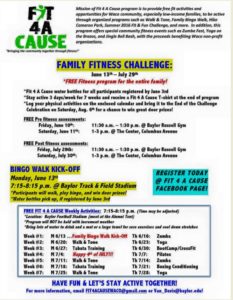 At first, I was so excited for this free exercise class and to stretch out my body that I didn’t notice much about the other people stretching out around me. I soon realized something was different about this class. This was not an ordinary free workout for those associated with Baylor. This was a Waco community workout. The workout students were a diverse group of people. I do not mean in exercise level. (But there were some people doing level three the entire time, and it wasn’t me). I mean in class, race, and gender. I saw people from all ends of the spectrum. I do not want to speculate what those people did for a living nor their education level, but let’s say we represented Waco. You had my friend and I both childless African American Baylor graduates and the middle-aged Hispanic women next to me with her three children.
At first, I was so excited for this free exercise class and to stretch out my body that I didn’t notice much about the other people stretching out around me. I soon realized something was different about this class. This was not an ordinary free workout for those associated with Baylor. This was a Waco community workout. The workout students were a diverse group of people. I do not mean in exercise level. (But there were some people doing level three the entire time, and it wasn’t me). I mean in class, race, and gender. I saw people from all ends of the spectrum. I do not want to speculate what those people did for a living nor their education level, but let’s say we represented Waco. You had my friend and I both childless African American Baylor graduates and the middle-aged Hispanic women next to me with her three children.
I took particular interest in two women. The first was a middle-aged white woman with two middle school-aged children. Honestly, the reason I took interest was negative. Both of the children were right in front of my friend and their mats kept blowing towards her. I was confused as to why neither the woman nor her kids tried to stop them. The mat blowing towards my friend thing happened a few times. I must admit, at first I was frustrated. I take exercise seriously! This seemingly unnecessary distraction was messing with my workout!
God quickly quieted my spirit and reminded me that this is the Church. This is what the community I say I want to be a part of looks like. There are Hispanics mothers, black men, Baylor students and graduates, all sharing the same space. I quickly got over my frustration, changed my attitude, and continued exercising.
The second women I took interest in was a black woman in her late 50s or early 60s. She sat elevated in the back of class. She was not on the ground for apparent health reasons and could not complete all of the exercises. Her determination to move and get healthy inspired me. She never quit moving, and I saw focus on her face as she completed each exercise. She gave me some new perspective on health. She showed me that every little bit helps. My only regret from this day is not talking to her. I should have asked her about her life, what brought her out on that day, what her family is like? I let this moment pass by.
When you are a part of something great you do not always realize until you take a step back.
I reflected on the experience the next day. I gained more appreciation for the town I live in. I loved Waco before. I love it a little bit more each time I interact with its people. This day was no different. This one event showered me with lessons. I realized how important it is to model healthy behaviors for the next generation as mothers exercised in front of and with their children. I saw diverse groups coming together with a common goal and nothing negative happened…something that felt like a contrast to what is happening in our country right now. I saw how important it is to take opportunities for conversation when they arise. These conversations create bridges across lines that usually divide us. This community workout is ripe with men and women from different backgrounds. Imagine what I could have gained from talking to that older lady for five minutes.
 By day, Jasmine Wise is a graduate student in the department of Sociology at Baylor University working on her Ph.D in Applied Sociology. By night, she is a youth leader at Acts Church in Waco, TX. By weekend, she develops her passions for public speaking, growing churches, developing communities. She wrote her first book, “Confessions of a Sinner”, in the Summer 2015. If you want to get in contact with Jasmine, please visit her website: drjkaw.com.
By day, Jasmine Wise is a graduate student in the department of Sociology at Baylor University working on her Ph.D in Applied Sociology. By night, she is a youth leader at Acts Church in Waco, TX. By weekend, she develops her passions for public speaking, growing churches, developing communities. She wrote her first book, “Confessions of a Sinner”, in the Summer 2015. If you want to get in contact with Jasmine, please visit her website: drjkaw.com.
The Act Locally Waco blog publishes posts with a connection to these aspirations for Waco. If you are interested in writing for the Act Locally Waco Blog, please email [email protected] for more information.
By Ashley Bean Thornton
Ten years ago this summer I took a trip to New Orleans that changed my life. I went there for youth camp with the kids from my church. The camp had a focus on “missions,” and the “mission” that year was Hurricane Katrina clean up. Even though it had been a year since Katrina, the Ninth Ward where we were working was still the biggest mess I have ever seen or ever hope to see. The devastation from the storm was terrible, but that’s not what changed my life. It was like the storm had ripped the lid off the city so that it was easy to see the poverty and the wealth and everything in between. It seemed like the mess was already there, the hurricane just laid it bare.
I was 45 years old and I don’t think I had ever thought about “the systems” of a community and how they worked, much less whether they were fair or good. I think for my whole life I had been mainly just a “consumer” of my community. Busy using what I liked – schools, hospitals, roads, fun things to do — I hadn’t given much of a thought to what a community “should” be like, or the work that goes into shaping a community, or that I might have some responsibility for helping to create a good community.
That week in the Ninth Ward flipped a switch in me. I felt like the systems in New Orleans were broken – that all these people living in poverty was a terrible waste of potential and that our society couldn’t afford that waste. When one of the youth on the trip reminded us that the rate of poverty in Waco was just as bad as that of New Orleans, I began to feel a personal responsibility. I began to feel strongly that for all our sakes, we had to do better. I started trying to learn more about poverty, about what we could and should be doing, about what I could and should be doing.
Learning about poverty has been like dropping through Alice In Wonderland’s rabbit hole into a whole confusing, tangled spaghetti bowl of problems and opinions and statistics and theories and theology and political stratagems and turf issues about education and workforce development and affordable housing and health care and neighborhood development and all kinds of other interwoven issues. I learned that there’s a name for these kinds of tangled up messes where nobody knows what to do to make it better – they’re called “wicked problems.” Appropriate name. Trying to work on the “wicked problem” of poverty here in Waco has been an exercise in self-doubt and generally always feeling overwhelmed and ignorant.
All that to say…I wish I had never gone on that trip to New Orleans!
Ha! Kidding! (sort of…) It is frustrating, but it also feels like work worth doing, and I am in love with the idea that a community of people can work together to set goals and solve problems and accomplish things together if we can only figure out how and stick with it. Ten years in, I would like to think I had figured out a few things in that regard…kind of a unified theory of how to get things done…but I haven’t. All I have to show for my efforts is a pile of random, half-formed ideas. Here are a few of them…maybe you can help me make sense out of them as we are working together these next ten years…
- Focus on what you want, not what you don’t want. – We want a great community for everyone who lives here, not just “not poverty.” Keep the real goal…the higher goal… in mind.
- When it gets right down to it, relationships are what make things happen.
- Have faith that the faith you have is enough faith to keep going and to do some good.
- Participate and help at least ten times more than you criticize.
- It’s not enough to just be compassionate; we have to also try to be smart. We have to learn to use information better. But, we have to be compassionate too.
- Work with the people who want to work with you…if the others come along later, great, but don’t waste time and energy trying to drag them.
- Don’t feel like you always have to invent a new thing. Chances are, someone is already doing something. Listen to them. Learn from them. Build on what they are doing.
- It does cost money to do stuff. Not everything can be done for free or cheap. (But if you don’t have money, there is still stuff you can do.)
- Try things – they might not always work, or work like you think they will, but you will almost always learn more than you would by talking and not trying.
- It’s easy and more comfortable for White people to ignore the role that race plays in all this. Don’t ignore it.
- When in doubt, err on the side of boldness.
- Do what you think is right – people are going to gripe at you either way, so you might as well do what you feel good about.
- If you don’t have any ideas about what to do, go around the table and have everyone share their ideas. There is probably some quiet person who has a great idea, but hasn’t said it.
- Sometimes you don’t need a new idea, you just need to apply the ideas you already have more consistently. Sometimes, though, you need a new idea.
- Keeping up with the details – the to-do list, the email list, the meeting notes – is half the battle.
- When in doubt, over communicate.
- “Them” is always us.
- Art and song and dance and joy and play and fun are central. They are not “fluff” to be ignored until we are done with the “important stuff.” They are the things that fuel the creativity and energy and passion we need to do the “important stuff.”
- Don’t forget to say “please” and “thank you.”
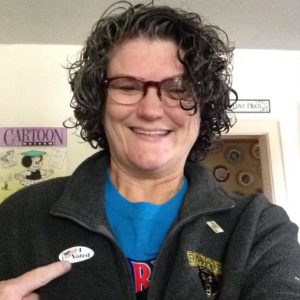 This Act Locally Waco blog post is by Ashley Bean Thornton, she works at Baylor, helps out with Act locally Waco, and facilitates the Waco Foundational Employment Network which is a part of Prosper Waco. She likes to walk and doesn’t mind at all if you honk and wave when you see her.
This Act Locally Waco blog post is by Ashley Bean Thornton, she works at Baylor, helps out with Act locally Waco, and facilitates the Waco Foundational Employment Network which is a part of Prosper Waco. She likes to walk and doesn’t mind at all if you honk and wave when you see her.
The Act Locally Waco blog publishes posts with a connection to these aspirations for Waco. If you are interested in writing for the Act Locally Waco Blog, please email [email protected] for more information.
